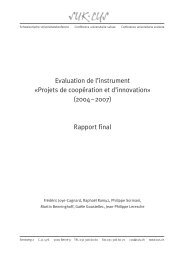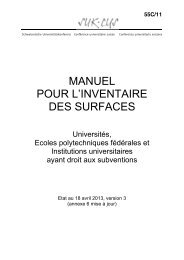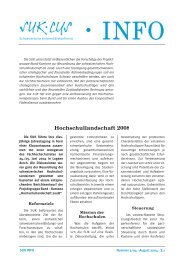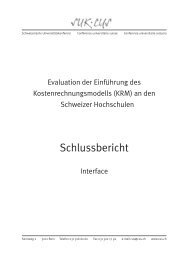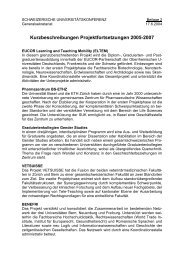Evaluation of the Swiss Virtual Campus - Schweizerische ...
Evaluation of the Swiss Virtual Campus - Schweizerische ...
Evaluation of the Swiss Virtual Campus - Schweizerische ...
You also want an ePaper? Increase the reach of your titles
YUMPU automatically turns print PDFs into web optimized ePapers that Google loves.
SVC Final <strong>Evaluation</strong>. Background Report Lepori and Probst<br />
30000<br />
25000<br />
20000<br />
15000<br />
10000<br />
5000<br />
0<br />
UNIBAS<br />
UNIBE<br />
UNIFR<br />
UNIGE<br />
UNIL<br />
UNILU<br />
Figure 2. Students <strong>of</strong> higher education institutions, 2006/2007<br />
UNINE<br />
UNISG<br />
UZH<br />
UAS: bachelor and license students; Universities and FIT: licence, bachelor, master and PhD<br />
students.<br />
Both <strong>the</strong> monitoring reports and our interviews show a quite diverse situation concerning<br />
elearning strategies and commitment <strong>of</strong> <strong>the</strong> rectorates in <strong>Swiss</strong> HEIs. In some <strong>of</strong> <strong>the</strong>m, ei<strong>the</strong>r<br />
<strong>the</strong>re is an elearning strategy approved by <strong>the</strong> rectorate or elearning is directly integrated in <strong>the</strong><br />
overall institutional strategy. In <strong>the</strong>se cases, it was also easy to find an interview partner in <strong>the</strong><br />
rectorate or directorate (mostly <strong>the</strong> vice-rector education), who was able to give precise<br />
answers concerning <strong>the</strong> university objectives and measures for elearning. In <strong>the</strong>se cases, <strong>the</strong>re<br />
is also a strong push towards integrating <strong>the</strong> elearning strategy with <strong>the</strong> overall development <strong>of</strong><br />
education and didactics and exploiting elearning to solve some <strong>of</strong> <strong>the</strong> issues raised by <strong>the</strong><br />
Bologna reform, including <strong>the</strong> need for restructuring curricula, <strong>the</strong> increase <strong>of</strong> <strong>the</strong> workload <strong>of</strong><br />
teachers and <strong>the</strong> increasing number <strong>of</strong> students.<br />
In o<strong>the</strong>r cases <strong>the</strong> situation is more difficult, since, as emerged from our interviews, <strong>the</strong><br />
development <strong>of</strong> elearning at <strong>the</strong> institutional level is essentially a task <strong>of</strong> <strong>the</strong> CCSP leader who<br />
has also to convince <strong>the</strong> rectorate <strong>of</strong> <strong>the</strong> importance <strong>of</strong> elearning and <strong>of</strong> <strong>the</strong> need for funding <strong>the</strong><br />
CCSP. Lack <strong>of</strong> institutional support was in <strong>the</strong>se cases explicitly indicated as a problem for <strong>the</strong><br />
diffusion <strong>of</strong> elearning; a consequence is also <strong>the</strong> different levels <strong>of</strong> development in <strong>the</strong><br />
departments, depending on <strong>the</strong>ir preferences and interests. In some cases (see <strong>the</strong> CCSP<br />
description), CCSP leaders still have to get <strong>the</strong>ir strategy approved by <strong>the</strong> rectorate and, in one<br />
case, <strong>the</strong> strategy was refused by <strong>the</strong> university directorate.<br />
However, in our opinion, <strong>the</strong> overall picture looks positive, since in <strong>the</strong> directorates <strong>of</strong> most<br />
<strong>Swiss</strong> higher education institutions <strong>the</strong>re is an awareness <strong>of</strong> <strong>the</strong> importance <strong>of</strong> elearning and <strong>of</strong><br />
<strong>the</strong> need for investment in this area. Large variations are however found in <strong>the</strong> degree <strong>of</strong><br />
implementation <strong>of</strong> such a strategy.<br />
3.2 CCSP: an overview <strong>of</strong> <strong>the</strong> current situation<br />
The establishment <strong>of</strong> a centre <strong>of</strong> competence, support and production CCSP in each <strong>Swiss</strong><br />
higher education institution has a been a priority <strong>of</strong> <strong>the</strong> SVC programme; it was expected that<br />
<strong>the</strong>se centres would significantly help to reduce <strong>the</strong> implementation costs <strong>of</strong> elearning, thanks to<br />
<strong>the</strong> accumulation <strong>of</strong> experience and standardization <strong>of</strong> technology. Thus, CCSPs should have<br />
21<br />
USI<br />
EPFL<br />
ETHZ<br />
SUPSI<br />
BFH<br />
FHNW<br />
FHO<br />
HSLU<br />
HES-SO<br />
ZFH





